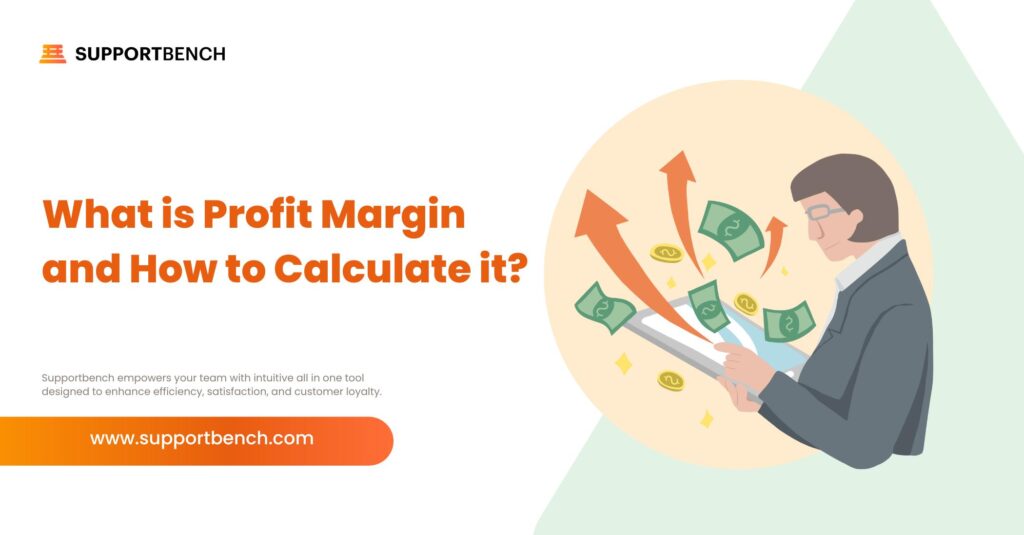Your company’s profit margin is the secret code to understanding its success. To some, it may be just one number, but it actually says much about the overall health of a company in terms of its profitability. It measures how much of your revenue remains after covering costs and shows the degree of efficiency with which your business operates.
Profit margin isn’t just about knowing whether you’re making money; it’s about leveraging that knowledge to make smarter decisions for growth and sustainability.
In this blog, we will cover the different types of profit margins, how one calculates them, and more importantly, how to make use of that information to fuel the success of a business.
What is Profit Margin?
Before we get down to calculations and strategies, let us first define what ‘profit margin‘ means. This metric is valuable in bringing out the health and potential of your venture.
Profit margin measures the percentage of revenue that becomes profit after expenses are paid. This will help you in evaluating the efficacy and success of your company.
Profit margin is more than just a number; it is your business’s heartbeat. It shows how much of every dollar in sales your company keeps as earnings. So, a higher profit margin means that you have a more profitable and efficient company compared to one with a lower margin.
Knowing your profit margin is one of the most important components of intelligent decision-making. It states everything from pricing to where the company may be going in the future.
It also helps in keeping track of the proper financial status of your operations, indicating places where you are performing well and where you need to improve.
Types of Profit Margins
There are three types of profit margins that business owners, accountants, lenders, creditors, and investors use. You can calculate your company’s gross profit margin, operating profit margin, or net profit margin using the following formulas. Read our breakdown of each margin to learn more.

Gross Profit Margin
Gross profit is the most available profitability measure. It reflects the profit remaining after deducting the cost of goods sold (COGS) from the total income. The COGS includes all of the direct expenses related to the production of goods such as raw and labor costs that are considered among the key expenses.
The gross profit does not include any expenses for debt, taxes, operational expenses, or one-time purchases, such as equipment. The gross profit margin compares gross profit to total revenue and it shows what percentage of each dollar earned is profit after production costs.
The formula to determine gross profit is:
Gross profit = revenues – cost of goods sold
Once you calculate gross profit, you can determine the gross profit margin using this calculation:
Gross profit margin = (gross profit ÷ revenue) x 100
Generally, gross profit margin provides insight into the profitability of specific items rather than an entire business. Calculating gross margin will let you easily see whether you’re putting too much time or labor into something.
Operating Profit Margin
Operating profit is what remains after deducting the cost of making your products and the costs associated with operating or running your business. COGS refers to the direct costs of producing goods or services, whereas operating expenses include but are not limited to rent, payroll, marketing, and inventory software. It doesn’t include costs like interest or taxes.
First, calculate your operating profit:
Operating profit = revenue – cost of goods sold – operating expenses
The formula for operating profit margin is:
Operating profit margin = (operating profit ÷ revenue) x 100

Net Profit Margin
The net profit margin shows how a company takes each dollar of revenue and transforms it into actual profit. The net income is the final amount that becomes available after accounting for the overall cost and other incomes. These include costs of goods sold, operating expenses, debt settlements, taxes, one-time expenses, and income generated from investments or other sources.
In general, net profit margin refers to what’s left after you subtract COGS, OPEX, interest, and taxes.
Use the following formula to find your net profit:
Net profit = revenue – cost of goods sold – operating expenses – interest – taxes
Next, substitute your variables into the net profit margin formula:
Net profit margin = (net profit ÷ revenue) x 100
Conclusion
Understanding and monitoring the profitability of your business is very important for making informed decisions that foster growth and sustainability. Through the calculation of gross, operating, and net profit margins, you can figure out where a company excels and where it should work on its improvements for efficiency to be at its best. Profit margins are indicators, not only financial but also the master key that will unlock the real potential of your business.
This means that for businesses that want to provide extended support to their customers and ensure their success, using tools like Supportbench will go a long way in smoothing operations and bringing in better overall performance. For more about how Supportbench supports your growth, get started with Supportbench.
FAQs
1- What is the difference between profit percentage and profit margin?
Profit margin is calculated with the selling price (or revenue) taken as base times 100. It represents a percentage of the selling price that is converted to profit, whereas “profit percentage” or “markup” is the percentage added to the cost price that one gets as profit on top of the cost price.
2- What is the difference between markup and profit margin?
The main difference between profit margin and markup is that margin equals sales minus the cost of goods sold; markup is the selling price of a product minus its cost price.
The Margin = Sales – COGS
The Markup = Selling Price of a Product – Cost Price of the Product.
3- What is a good net profit margin?
A healthy profit margin for a small business is usually between 7% and 10%. However, some businesses, like retail or food companies, may have lower margins due to higher costs.












